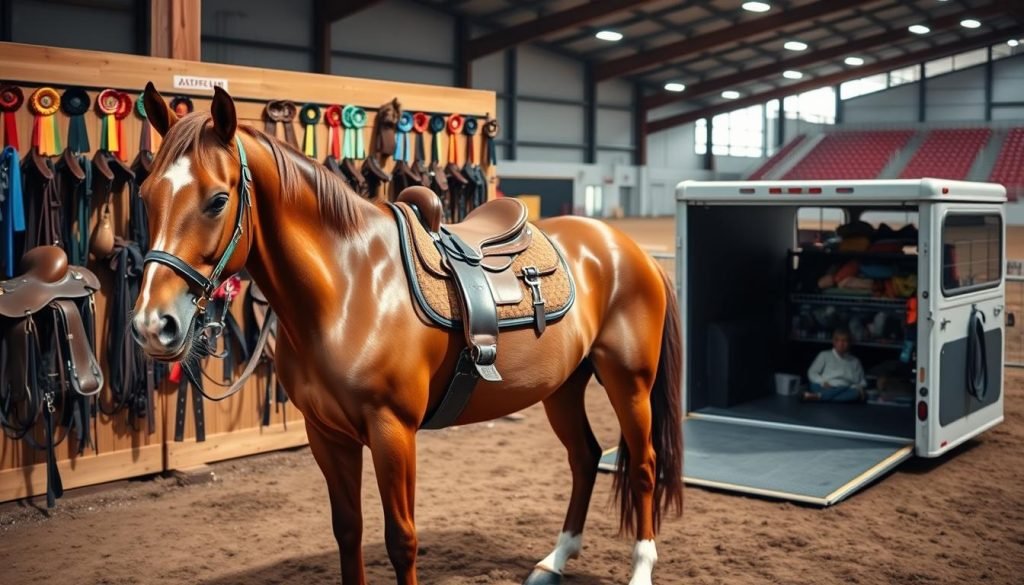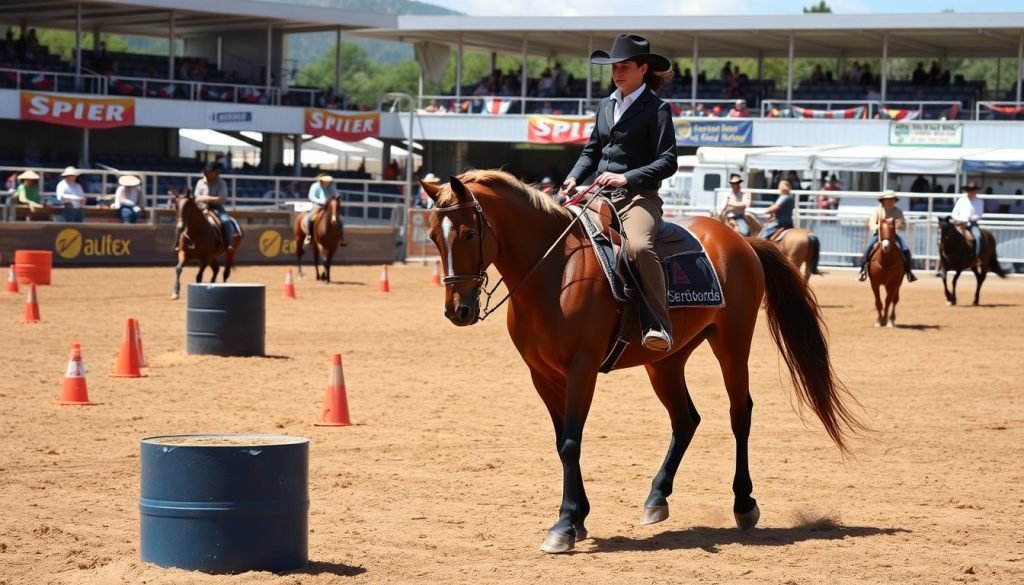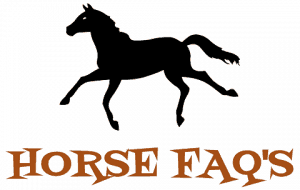Are you ready to saddle up and step into the spotlight of your first Western riding show? The journey from dreaming about competition to actually competing can be both thrilling and overwhelming. But what if the key to a successful experience lies not just in your performance, but in your preparation? Understanding how to prepare for your first Western riding show involves more than just mastering a routine; it’s about equipping both you and your horse for an enjoyable and memorable experience.
This guide will take you through essential preparation steps to ensure horse show readiness, from selecting the right show to understanding the rules and regulations that govern western equestrian competitions. With insights on attire, equipment, and mental readiness, you’ll be empowered to shine in the arena while enjoying every moment of the journey.
Be sure to check out what to expect in your first riding as you get started!
Key Takeaways
- Understand different types of Western riding competitions.
- Prepare your horse physically and mentally before the show.
- Know the specific class requirements and attire needed.
- Practice vital horsemanship skills consistently.
- Maintain your tack and equipment to ensure safety and professionalism.
Understanding Western Riding Competitions
Western equestrian competitions showcase a variety of classes, each designed to highlight unique skills and techniques. Participating in these events requires adequate preparation and a clear understanding of the different categories available. Each type has specific requirements that competitors must meet, allowing them to demonstrate their abilities in a structured environment.
Types of Competitions
Competitors encounter several exciting western riding classes. Some of the most popular include:
- Reining: Demonstrates the horse’s ability to perform precise maneuvers, judged on smoothness and level of difficulty.
- Western Pleasure: Focuses on the horse’s style, relaxation, and way of going, evaluated solely on performance.
- Working Cow Horse: Involves a horse and rider working cattle, showcasing teamwork and responsiveness.
- Team Penning: Features riders tasked with separating specific cattle from a herd within a set time limit.
- Team Sorting: Requires a pair of riders to move cows from one pen to another while maintaining control.
- Cutting: Engages horses in separating a cow from its herd while demonstrating finesse and control.
Overview of Judge’s Criteria
Understanding what judges look for in western equestrian competitions is essential for effective quarter horse show preparation. Judges assess various aspects, including:
| Criteria | Description |
|---|---|
| Precision | Accuracy in executing maneuvers and patterns during the performance. |
| Presentation | The overall appearance of the horse and rider, including grooming and attire. |
| Responsiveness | The horse’s ability to react promptly to commands and cues from the rider. |
| Performance Quality | Evaluates the horse’s movement, including natural head carriage and gait consistency. |
Before the Show: Essential Preparations
As the show day approaches, the focus should shift to crucial preparations that contribute to horse show readiness. Getting your horse in peak physical shape is essential. This involves a well-thought-out training plan tailored for reining competition training, emphasizing proper exercises to enhance performance. The right routine will ensure your horse is energetic and agile, ready to dazzle judges at the event.
Getting Your Horse in Shape
A regular training regimen is foundational. Engage in activities such as:
- Daily grooming to keep the coat shiny and healthy.
- Conditioning exercises that build stamina and strength.
- Practicing specific movements related to your competition class.
These steps will not only help improve your horse’s physical capability but will also contribute positively to its mental readiness for the competition.
Cleansing Your Equipment and Tack
Cleansing your equipment and tack should not be overlooked. A well-maintained saddle and bridle play a significant role in ensuring both comfort and optimal performance. Clean equipment enhances your overall presentation, highlighting the care and respect you have for your horse and the sport. Ensure:
- All tack is free from dirt and debris, checked for wear and tear.
- Polished boots and a neat appearance for both rider and horse.
- Proper fitting halters and saddles, promoting comfort and safety.
Completing these preparations will not only set a good example but also heighten your confidence as you enter the show ring.

How to Prepare for Your First Western Riding Show
Preparation for a quarter horse show is essential to ensuring success and enjoyment throughout the event. Riders must take the time to know their specific class requirements and familiarize themselves with the expectations that come with performing in western pleasure classes.
Know Your Class Requirements
Each class in a western riding competition presents distinct requirements that participants need to meet. This can include attire specifications, such as appropriate boots, hats, and attire, along with equipment guidelines. It’s vital to understand the rules and regulations associated with your chosen class, as subtle differences can vary from one show to another. This knowledge is crucial to avoid small oversights that could lead to disqualification. Reading the rulebook thoroughly will equip riders with the information necessary to stand out during their competition.
Understand the Rules and Regulations
Being well-versed in the rules and regulations enhances a rider’s confidence and allows for a more focused approach to preparation. Riders can reduce anxiety knowing they are fully prepared. Important regulations often include safety standards, horse health requirements, and operational guidelines during the show. For comprehensive insights, refer to this guide on essential horseback riding tips. Taking time to understand the various aspects of quarter horse show preparation ensures a smoother experience, leading to long-lasting enjoyment of the sport.
Practicing Your Skills
As the show day approaches, focusing on skill development becomes paramount for success in Western riding. Prioritizing showmanship techniques, honing horsemanship patterns, and engaging in reining competition training can significantly enhance performance. Mastering these core skills not only builds confidence but also ensures athletes are well-prepared for the competition.
Showmanship Techniques
Effective showmanship involves leading and positioning your horse with finesse and control. Important aspects include:
- Establishing a strong connection with your horse.
- Practicing the optimal stance for showcasing your horse’s strengths.
- Displaying confidence through posture and demeanor.
Understanding what judges look for, such as smoothness and balance, can elevate your performance. Preparing for potential questions about showmanship standards can assist in executing the required techniques smoothly.
Horsemanship Pattern Practice
Regular practicing of horsemanship patterns is essential. Riders should focus on transitioning through various movements and demonstrating accuracy. Elements to consider include:
- Memorization of the pattern to ensure fluid execution.
- Maintaining cadence and rhythm throughout the sequence.
- Incorporating feedback from trainers or peers to refine techniques.
Familiarizing yourself with the judging criteria related to horsemanship patterns can prevent penalties during the actual competition. Knowing the specific qualities expected in your performance enhances preparation.
Reining Competition Training
Incorporating reining competition training allows riders to perfect their skills with speed and precision. Key focus areas for training sessions include:
- Practicing stops and rollbacks to develop sharpness and responsiveness.
- Ensuring the horse maintains balance during spins and maneuvers.
- Understanding the importance of executing movements cleanly to avoid penalties like missing a stopping point.
In essence, thorough preparation through these specialized techniques can significantly contribute to a successful show experience.

Training for Ranch Riding Events
Preparing for ranch riding events encompasses various factors that significantly contribute to an enjoyable and successful experience. Attending to groundwork while developing trail course strategies lays the foundation for a well-rounded performance.
Groundwork and Teamwork with Your Horse
Groundwork serves as the cornerstone for achieving effective communication and partnership between horse and rider. It involves seamless interactions that enhance your horse’s responsiveness to cues. Focus on building trust, as this connection will shine during ranch riding events.
- Establish clear cues: Ensure your horse can respond promptly to verbal and physical signals.
- Improve responsiveness: Practice backing up, side-passing, and moving forward on command.
- Foster trust: Spend quality time together, creating a comfortable and familiar environment.
Trail Course Strategies
Mastering trail course strategies can enhance your performance in competitions that simulate real-world ranch scenarios. Understanding the obstacles your horse will face is essential to minimize anxiety on the day of the event.
- Familiarize with obstacles: Introduce your horse to various challenges such as bridges, poles, and mailboxes.
- Practice transitions: Work on smooth transitions between different gaits, ensuring fluid navigation.
- Improve confidence: Gradual exposure to potential obstacles will help build your horse’s self-assurance.
By focusing on these aspects of groundwork and implementing thoughtful trail course strategies, competitors can enter ranch riding events well-prepared and poised for success.
Clothing and Presentation
When participating in any western pleasure classes, making the right impression involves selecting appropriate attire. Riders should express their personal style while adhering to the standards of the show. Evaluating the significance of choosing the right outfit goes hand in hand with ensuring that the equipment remains clean and fits properly.
Choosing the Right Outfit
For local western shows, which are often relaxed yet competitive, the attire typically includes a certified helmet or cowboy hat, a long sleeve button-up shirt, jeans, a belt with a buckle, and cowboy boots. While chaps or chinks are optional, they can enhance the overall look of the rider. It’s crucial to note that short sleeve button-up shirts are not acceptable in the show ring, regardless of discipline.
In showmanship classes, presentation plays a vital role. A polished appearance can be achieved with a long sleeve button-up shirt, a slinky top, and bootcut show pants, complemented by a vest, belt with buckle, and cowboy boots. Many riders also choose to wear a show jacket for added sophistication, ensuring they stand out in the arena.
Importance of Tack Cleanliness and Fit
The importance of tack cleanliness cannot be overstated. Clean and well-fitted tack enhances the horse-rider combination’s presentation and reflects professionalism. Regular maintenance not only showcases respect for the sport but also ensures the equipment functions optimally. Riders should include proper grooming of saddles and bridles in their pre-show preparations.
Properly fitting tack is essential for the comfort of both horse and rider. Ensuring that everything fits correctly can prevent accidents and allow for smooth movements during events. Properly maintained tack, coupled with attention to appearance, elevates the overall experience in western pleasure classes.
Day of the Show: What to Expect
The day of the show is an exciting yet critical phase in the competition journey. Familiarizing yourself with the environment and ensuring you properly prepare can help create a smooth experience. On this day, arriving early for warm-up becomes essential. This extra time allows both rider and horse to mentally and physically prepare while reducing pre-show jitters.
Arriving Early for Warm-Up
Arriving early for warm-up provides the opportunity to establish a connection with your horse and focus on necessary adjustments. This time allows you to:
- Familiarize yourself with the layout of the venue.
- Explore the warming-up zones and understand the show rings.
- Create routines that ease nerves for both the horse and rider.
Understanding the warm-up etiquette is just as important as the warm-up itself. Being considerate of other riders and following the guideline of passing left shoulder to left shoulder helps maintain a positive environment.
Understanding the Show Environment
The atmosphere on the day of the show can be significantly different from typical training sessions. The energy levels often increase, making it crucial for riders to adapt quickly. To better acclimate during the event, consider the following:
- Take note of the sounds and activities that may be more pronounced than usual.
- Stay focused on your routine while remaining aware of your surroundings.
- Sculpt your mindset to reflect confidence and composure in this dynamic environment.
Ultimately, understanding the show environment helps riders shine in their performance and embrace the spirit of competition.
Tips for a Successful Show Experience
Embarking on your first western riding show can be both thrilling and nerve-wracking. Implementing effective strategies can ease your concerns, leading to a more positive experience. Start by focusing on building confidence and composure through various preparatory activities.
Building Confidence and Composure
To enhance your show experience, consider these essential tips:
- Visualization techniques can significantly improve performance. Picture yourself executing your routine effortlessly.
- Engaging in positive self-talk helps in combating nerves. Encourage yourself with affirmations and reminders of past successes.
- Familiarizing yourself with the show environment beforehand gives a considerable advantage. Attending as a spectator can provide insights and reduce anxiety.
- Ensure a good night’s sleep before the event. Alertness plays a crucial role in performance, both for you and your horse.
Learning from Judges and Other Competitors
Gaining insights from judges and peers enriches your experience. Here are key points to bear in mind:
- Take notes during your ride. Understanding judges’ feedback can be invaluable for future performances.
- Engage with fellow competitors. Sharing experiences fosters a sense of community and opens doors for valuable advice.
- Watching others can provide practical learning opportunities. Pay attention to successful riders and their techniques.
- Remember to celebrate all accomplishments, regardless of the results. Each show is a chance to grow and learn.
Conclusion
As you prepare for your first Western riding show, remember that thorough preparation is key to a successful and enjoyable experience. Understanding the various types of competitions and the specific judge’s criteria can greatly enhance your confidence. You’ve learned that a well-trained horse must showcase their abilities through smooth gaits, including a flat-footed walk, a well-executed jog, and a rhythmic lope. Familiarizing yourself with these expectations is critical in your journey of how to prepare for your first Western riding show.
Furthermore, it’s important to practice diligently, focusing on essential techniques in showmanship and horsemanship. Each practice session is an opportunity to refine your skills and build a trusting partnership with your horse. Remember, mastering the lead changes and executing your riding patterns can make a significant difference during the competition. With the right mindset and extensive practice, you can navigate the complexities of these events while keeping penalties minimal.
Finally, embrace every showing opportunity as a step towards growth in your equestrian journey. The world of Western riding competitions is both challenging and rewarding. Use what you’ve learned about how to prepare for your first Western riding show to foster your passion for horses and continue to develop as a rider. Enjoy the camaraderie and insights gained from fellow competitors and judges alike, and let your love for this sport shine through when you enter the arena.
FAQ
What should I wear for my first Western riding show?
Aim for a neat and functional outfit that reflects your personality while adhering to class standards. Ensure that your attire is clean and fits properly, as this contributes to your overall presentation.
How do I prepare my horse for the competition?
Focus on getting your horse in peak physical conditioning through tailored exercises for each specific competition. Additionally, incorporate groundwork to strengthen your bond and enhance communication.
What are the different types of Western riding competitions?
The main types include reining, trail, horsemanship, showmanship, and ranch riding events. Each class emphasizes different skills and requirements for both horse and rider.
How can I improve my showmanship techniques?
Practice leading and positioning your horse effectively. Work on displaying control and rapport with your horse, ensuring they are responsive to your cues.
What should I do on the day of the show to be prepared?
Arrive early to allow time for warm-ups and adjustments. Familiarize yourself with the layout of the venue and practice staying composed in the energetic show environment.
What kind of maintenance should I do for my tack before the show?
Thoroughly clean all equipment, including saddles and bridles, ensuring they are well-fitted and in good condition. A clean and polished appearance reflects professionalism and respect for the competition.
Why is it important to know the judge’s criteria?
Understanding the judge’s expectations helps you focus on areas for improvement, such as precision, presentation, and responsiveness, which can ultimately enhance your scores.
How can I build confidence before my first show?
Utilize visualization techniques and positive self-talk. Observing and learning from judges and fellow competitors can also provide valuable insights and boost your confidence.
What are effective strategies for navigating trail courses?
Familiarize your horse with various obstacles to enhance their confidence and responsiveness. Practice navigating different scenarios to simulate real-world ranch situations.
